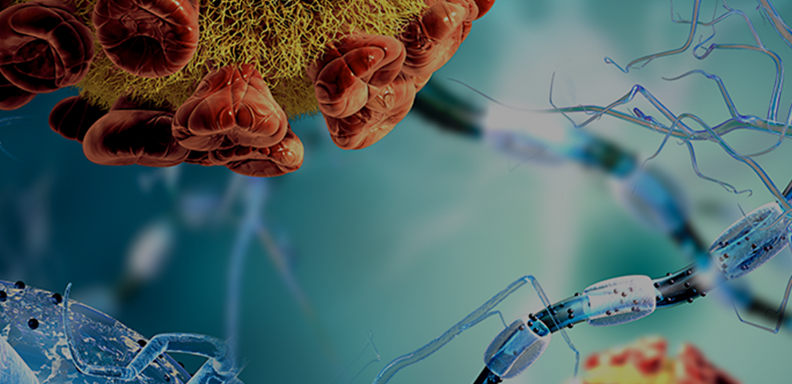Researchers at the University of Chicago and the University of Rochester have developed technology that allows them to examine individual extracellular vesicles (EVs), nano-sized particles released by all types of cells that carry a cargo of proteins, lipids, metabolites, and genetic material. They used this new platform to study how pH levels are maintained inside the vesicles, which could help researchers understand how to harness these mysterious particles someday for medical treatment or as biomarkers.
The system was developed with microfluidics devices that use extremely thin membranes filled with tiny pores that capture individual EVs, which can be as small as 40 nanometers in diameter. The research, published January 10, 2022 in Communications Biology, is believed to be one of the first projects to successfully study the function of EVs at an individual level.
Because of their extremely small size, extracellular vesicles have proven difficult to study. They are produced by all types of cells in the body and are excreted into the bloodstream and other fluid filled cavities of the body. They were originally thought to be like little garbage bags, carrying away junk from the cells, but as researchers learned more, they began to see that they could play a more active role. There is evidence that they affect cells around them by binding to receptors, initiating signal pathways, and even traveling over a distance to a target cell—which some researchers believe could play a role in cancer metastasis.
Scientists are interested in how these particles interact with cells, but since they are so small and tend to be mixed up in a heterogeneous environment with EVs from many different types of cells, it has been hard to isolate their individual function. In the new study, Deborah Nelson, PhD, Professor of Pharmacological and Physiological Sciences at UChicago, and Vladimir Riazanski, PhD, a Research Associate Professor in Nelson’s lab, were interested in studying macrophages, immune cells that destroy pathogens, to understand the purpose of the EVs they produce. They used samples from the lungs, which included cells that line the alveoli plus various immune cells, and then worked to see how the vesicles they produce maintain pH inside their cargo.
“If the vesicles carried important genetic material, you'd want a fairly stable pH in that environment,” Nelson said. “So, we wanted to ask a basic question: Are there proteins in the vesicle surface that could be responsible for maintaining a stable pH environment in the inside of the vesicle?”
James McGrath, PhD, Professor of Biomedical Engineering at the University of Rochester, developed ultrathin membranes (just 100 nanometers thick) that are made from silicon nitride and covered with tiny pores that can capture individual EVs. These membranes are used in microfluidics devices that can circulate different fluids around the EVs in a controlled manner and measure the responses.
“The approach is based on our long history of doing microfluidics with ultrathin membranes,” McGrath said. “We’re particularly interested in the diagnostic potential of extracellular vesicles. Some years ago we recognized that our materials have the ability to catch and isolate individual EVs because the membrane pores and EVs are about the same size.”
He said he’s excited that the collaboration resulted in a groundbreaking application for the membranes. “Anytime our materials help a collaborator do first-of-a-kind science, it’s a big deal,” McGrath said. “This paper uses our materials to reveal an important detail in biology that has never been seen before.”
The team discovered that the EVs have a transporter protein on their surface called a sodium hydrogen exchanger that is common to all epithelial cells. Once they were able to stabilize the vesicles on the membrane, they could look at them with a powerful microscope and measure changes in the vesicles’ pH levels over time or in response to changes in the solution (although they’re so small they don’t actually see the changes inside the vesicle, but rather changes in fluorescence from a probe attached to them). The pH remained in a steady state inside the vesicle, and as the ionic content outside the vesicle changed, the exchanger began to function and prevented the pH from changing internally.
Because EVs can carry many different kinds of cargo, they present the possibility that someday they could be harnessed to transport drugs or genetic therapies in and out of cells, or be used as biomarkers to flag molecules of interest. While that prospect is still years away, the tools developed for this study mark an important first step.
“Once you have a mechanical platform that allows you to study function in a quantitative way, now we can look at how you might be able to recognize altered EVs and isolate certain subsets of the population,” Nelson said. “This was a first foray into understanding their functions at the single vesicle level.”
The study, “Real time imaging of single extracellular vesicle pH regulation in a microfluidic cross-flow filtration platform,” was supported by the National Institutes of Health and the Department of Defense. Additional authors include Gerardo Mauleon and Adriana M. Zimnicka from UChicago and Kilean Lucas and Samuel Walker from Rochester University.



